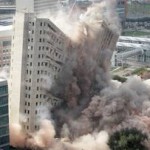Occasionally, I find current news stories that bring to mind an article that I posted in the recent past. Most of the time, I keep such reflections to myself –considering them only a matter of personal interest. However, my attention was drawn this past week to three developments that I decided were well worth your time and attention:
1) A scathing Business Week story that paints a wart-filled portrait of Sears Holding Corporation (SHLD) CEO, Eddie Lampert, and his decentralized, “dog eat dog” organizational model (splitting SHLD into dozens of autonomous business units, each competing for ever-dwindling financial and corporate resource) and his cold, arbitrary management style that reminds me of Attila the Hun (he is arrogant, aloof, autocratic; 98% of his interaction with executives is via video conference… carried out while he multi-tasks).
2) Something occurred that I have never experienced and never anticipated. On the evening of July 1st, Chicago Teamsters Local 727 announced the commencement of a strike by funeral directors and drivers against the sixteen Chicago-area funeral homes operated by Dignity Memorial (the brand name used by “death care” conglomerate, Service Corporation International (SCI), to market its hundreds of funeral homes across the U.S. and Canada).
3) The volatile action within the equity and fixed income markets since Ben Bernanke’s fateful May 22nd Congressional testimony has been well documented. Keeping that fact in mind, combined with an insightful article[1] I read warning investors in Berkshire Hathaway (BRK-B) to be mindful of the ethereal (in terms of quantification) but very real (in terms of market sentiment and public/press sentiment) “Buffett Premium” built into the price of BRK-B. The author’s point is that, just as Apple (AAPL) stock was significantly impacted by the death of Steve Jobs, so BRK-B’s price will be greatly buffeted whenever the U.S.’s best-known investor, Warren Buffett, passes from this life to the next. In light of these two matters, I thought it would be helpful to test out my March comment (in the article that drew key investment wisdom from Buffett’s annual shareholder letter) that an investor in BRK-B could reasonably expect S&P 500-like returns, but with lower volatility.
Let’s begin with Sears. In a July 11th report[2], Mina Kimes offers us whatever term describes the very opposite of a “puff piece” about the long-failed management style of Eddie Lampert, a billionaire cutthroat hedge fund manager who merged Sears and K-Mart in 2005. Despite the charade of four different CEO’s since 2005, Lampert has really run the sprawling empire from the start. At least I give him credit for ending the charade this year, when the prior CEO (Louis D’Ambrosio) couldn’t take it any more and quit. Lampert named himself CEO and did away with the CEO salary expense (the only unqualifiedly sound decision he has made at SHLD).
The total lack of retail expertise brought to the table by Lampert is reflected in his organizational model. Instead of uniting a management team around a unified vision and corporate objectives, he divided it into countless autonomous business units (“tribes”) and threw them into the arena to battle separately toward success. Lampert claims total devotion to free-market economics – counting on Adam Smith’s “invisible hand” to drive great results. He wanted members of management to act utterly selfishly, therefore running each division rationally and maximizing profit. When criticized about this style, Lampert concedes that, to outsiders, a decentralized system such as his “appears messier”. Here is a snapshot of just how “messy” his system has become during the past eight years:
1) Sales down almost 20%;
2) Stock down 64%;
3) Earnings are nonexistent (a loss of almost $1.4 billion TTM; – $13.20/share
4) Cash and cash equivalents on a steady decline
5) Current Ratio deteriorating (reflecting inability to meet short term liabilities with short-term assets; put simply, SHLD is hemorrhaging cash).
Meanwhile, since my prior article, SHLD price has done appropriately poorly (SHLD in blue). Note the May swoon (earnings and interest rate related). SHLD has done so poorly that even Macy’s (M) (green) (which has its own “warts”) has handily outperformed, as has the S&P 500 Index (red).
INVESTOR TAKE AWAY
I told you months ago and will reiterate it today — if you want to invest in retail, do not touch SHLD. It is strictly an “asset play”, the actual value of which will only be realized through creation of a REIT spinoff, or a sale (outright or piecemeal). If SHLD were a person, this would be an apt description:
1) A wealthy old woman or man in ICU, hooked up to IV’s;
2) Owns countless valuable assets a trustee is holding in expectation of future “unlocking” of value;
3) In the meantime, bits and pieces of the patient’s current assets (brands and individual properties) have been sold off as needed or as bid upon at an attractive price.
If you day trade, or if you enjoy roller coaster rides, go ahead and buy it (or sell it). Personally, I am staying away. I have trouble investing in a company run by a modern-day Attila the Hun who seems intent upon dismantling an empire piece by piece.
Next, on to Service Corporation International (SCI) — the giant North American conglomerate dominating the “death care” business. Think about this for a minute:
When your loved one dies (spouse, parent, child, aunt, etc.) do you want just anyone to pick up their remains, embalm them, help you decide how to remember them (obituary; service) and commit their remains, and finally oversee their committal? Of course not! You want this done by someone you trust – much as you need to trust a doctor caring for yourself or a loved one!
For over thirty years, I ministered to persons who lost a loved one, and walked with them through the entire grief process (“death care”) from beginning to end. I assure you that the person who handles the funeral home care and administration can make that experience more bearable (even “comfortable”) or more traumatic (unbearable) – and everything in between. I have personally experienced death care professionals who range variously along a spectrum of “good-bad-ugly”. I know whom I would trust and whom I would avoid. As you can guess, it is an extraordinarily sensitive area. (Fortunately, I can say that the majority of those I have known fall into the “good” category.)
That is the context within which I was quite surprised to see that Chicago-area funeral directors and drivers who are employed by one or more of the sixteen Dignity Memorial (funeral home arm of SCI) Chicago locations went on strike on July 2nd! These employees are represented by Teamsters Local 727 – which has represented them since 1946 and has never previously declared a strike! I will not pretend to be fully aware of all the issues involved. Instead, I will put it in a nutshell: SCI wants to adjust or eliminate pension and health benefits; in response, the employees have offered a reduced salary expectation in exchange for maintaining benefits. SCI was not willing to adjust its initial contract offer. The result is a strike. (If you want details, go to www.integrityinillinois.com).
The good news for SCI shareholders is that the stock did not suffer even a discernible “blip”, much less anything measurable:
However, the idea of a strike in the death care industry is worthy of serious reflection. It leads me to wonder what I’d do if my doctor went on strike just prior to my scheduled surgery – a rough parallel. Needless to say, it raised questions in my mind – questions for which I have not yet settled upon answers. It is important to note, however, that during the SCI/Union negotiations, a Teamster official alleges that: “The company admits it can easily afford to maintain these workers' benefits. They just simply won't because their business model calls for them to siphon more money out of the Chicago community…”. [3]
Source: Chicago Sun-Times
INVESTOR TAKE AWAY: As I wrote weeks ago, SCI offers a unique and potentially profitable investment option. There is no question about that. There is also no question that every business school and economist will agree that a business model must be profitable. I do not begrudge SCI its right to be a tough negotiator, just as I do not begrudge the directors/drivers their right to do all they can to preserve their benefits. However, we all need to be aware of the countless ways (tangible and intangible) in which these new dynamics will shape the death care business in the years ahead.
On a side note, I must applaud the directors/drivers for their sensitivity to those who grieving! As the strike began and they picketed the sixteen homes, they intentionally ceased their picketing (and disappeared) whenever there was a scheduled service – intentionally sparing grievers from the added trauma of having to wend their way through picketers. Good for them!
Finally, we move on to Warren Buffett, BRK-B, and the incalculable “Buffett Premium”. Back in March, I suggested that BRK-B might serve as an interesting proxy for the S&P 500, but with a lower level of volatility. In light of the May/June tumult caused by Ben Bernanke, I thought I should review for you the relative performance of each since March. Here is the graph, with BRK-B in blue and the S&P in red. Note the approximate 4% outperformance by BRK-B, an outperformance that must be adjusted downward about .5% each quarter to account for the current S&P 500 dividend yield. Yes, this is a very short time frame, but it hints at the truth of what I suggested.
That being said, I must warn us all that, as with Apple and other stocks associated with a peerless icon, there is an impossible to calculate “premium” imbedded in the stock price that will dissipate the day that Mr. Buffett (82 years old) departs this world. It is true that a succession plan is in place – very capable portfolio managers have been integrated into the fabric of BRK-B, and Buffett’s son will become CEO, to keep folks accountable. That is all well and good (and all that can be done short of cloning Buffett). However, when this demigod passes away, Berkshire’s headquarters automatically changes from Mt. Olympus to just another Omaha office building. The mystique of Berkshire melts away. The business press stops gushing about how wise and great “the Oracle” is and instead begins to catalogue and harp about all the worries, weaknesses, warts, and wasted opportunities that will inevitably emerge. No longer will BRK-B be offered special “deals” by the likes of Salomon Brothers, Bank of America (BAC), Wells Fargo (WFC), Goldman Sachs (GS), etc. (that each paid Buffett a high premium in exchange for timely financial infusions). No longer will a new stock buy by BRK-B carry immediate cache and credibility on Wall Street.
Alas, there is no easy “solution” to the “Premium” quandary posed by BRK-B. Regular call selling (which could increase total return over time) would reduce some of the risk. Offering more risk reduction (but detracting from overall return) is the option of holding a long-term put or put spread. The ideal “solution” would be to own a life insurance policy on Warren’s life, with a face value equal to (guessing here) 15% of the total invested in BRK-B. Good luck with that! (Here’s an intriguing Buffett business opportunity: Have one of his insurance units sell a life insurance policy on Warren to shareholders. The underwriting for that would be fascinating!)
Bottom line: There is no sure proof “cure” for this risk. It is a risk one must accept, or choose to not own BRK-B shares. The key point is that no investor should harbor the illusion that the risk is not real and significant! “Buyer beware”… or “buyer’s remorse” will surely result!
DISCLOSURE: The author does not own SHLD, SCI, or BRK-B shares. Nothing written above is intended as a recommendation to buy or sell anything. You should always consult with your investment advisor before initiating any new investment transactions!
Submitted by Thomas Petty MBA CFP
Related Posts
Also on Market Tamer…
Follow Us on Facebook

 Why Lockheed Martin Stock Soared While the Market Sagged Today
Why Lockheed Martin Stock Soared While the Market Sagged Today



